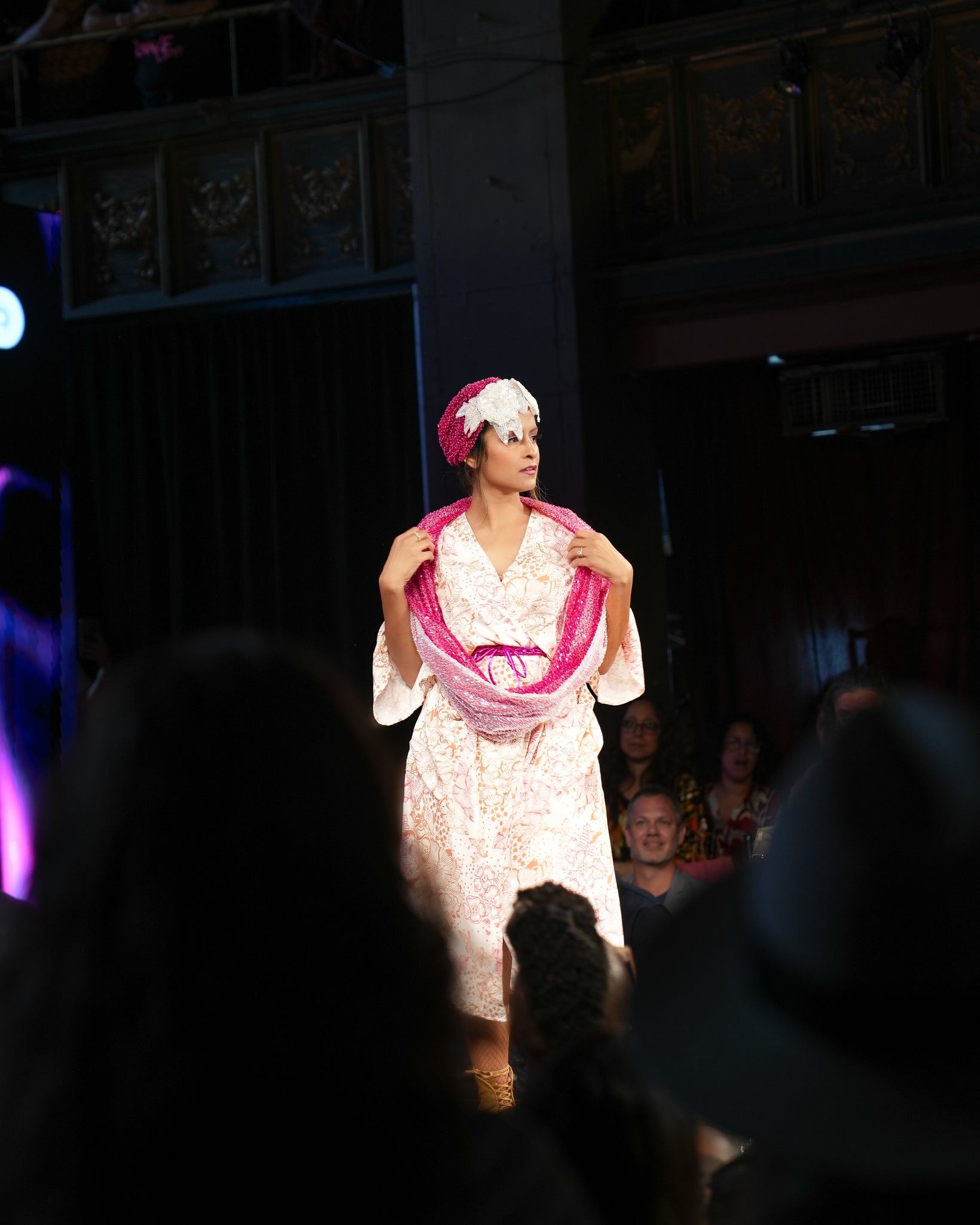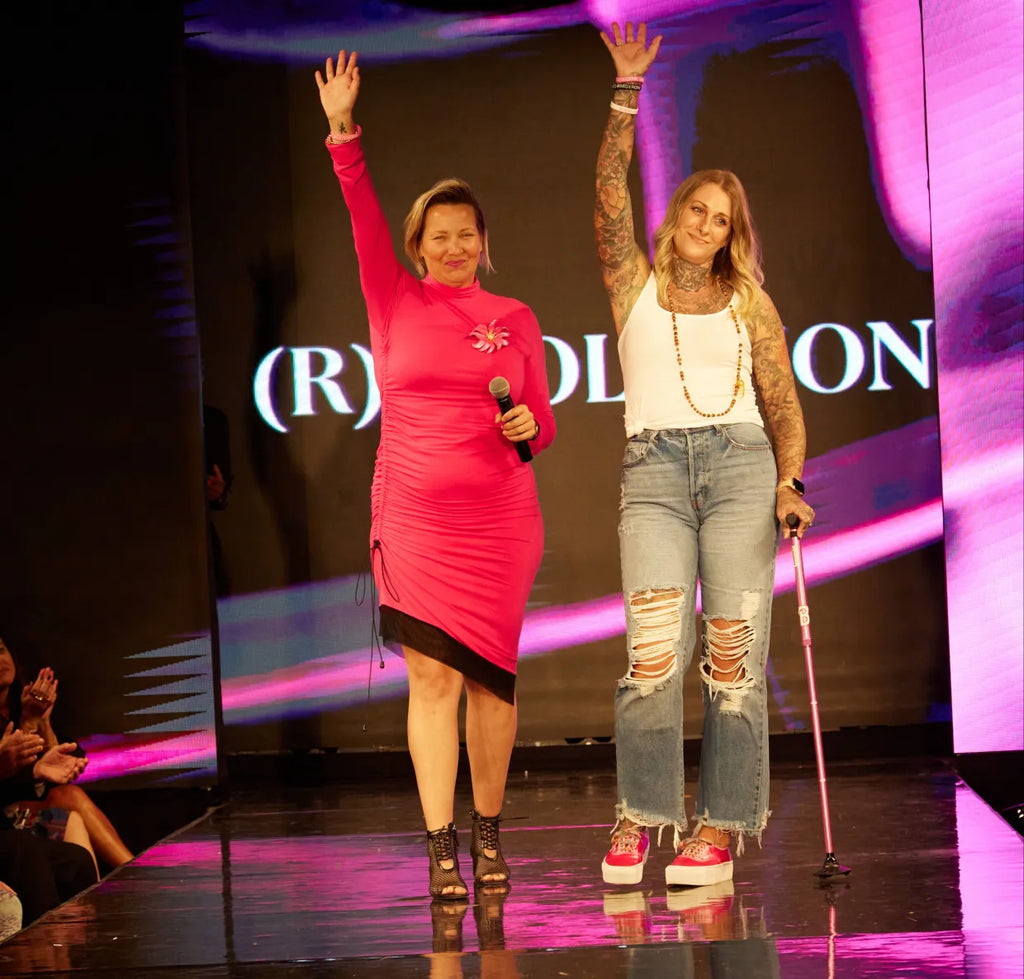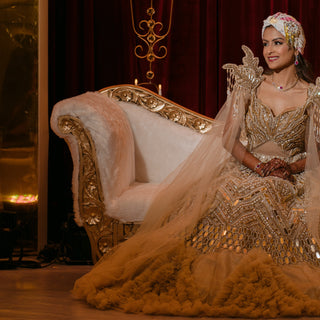
A DARING dame has bared it all on the catwalk in a particularly poignant moment during New York Fashion Week. The model and breast cancer survivor took off her bra and prosthetic breasts in a powerful statement regarding women's health.
Real estate agent Jamie Kastelic, 43, found a lump on her breast at 33 and knew right away that something wasn't right.
"I just had this gut feeling that it was bad, that it was cancer," the Michigan-based beauty exclusively told The U.S. Sun.
"I went to the doctor and I never told anybody other than my husband. I didn't tell my parents or anyone.
"And so when I found out that it was cancer, I went into the car in my garage and I called my parents and I cried."
Jamie ultimately beat breast cancer going on 10 years but chose to go flat-chested for the long term.
She skipped having traditional reconstructive surgery due to a near-death experience with breast implants.
SAY IT WITH YOUR CHEST
A decade after the diagnosis, Jamie walked the runway for Cancer Culture X AnaOno's fashion show on Sunday, September 10.
To model Dana Donofree's spring/summer 2024 designs — including a line of post-surgical intimates — the catwalk was taken over not by professional models but by breast cancer survivors.
Some had undergone surgery following their diagnoses, while others were still battling the disease.
Jamie took to the stage in a black bra, gray and white short shorts, and black fishnet stockings.
But after posing at the end of the runway, she made a surprise move, reaching into her bra and pulling out a prosthetic breast before removing the top completely.
Smiling, Jamie proudly bared her chest to the audience, revealing artwork by cancer survivor Marianne DuQuette Cuozzo drawn on her skin along each surgical scar and a heart dangling on one side.
Though the survivor is clearly at ease with her chest, she admitted she never thought she'd accept being flat.
"The whole theme of this is revolution and we were asked what that means to us," Jamie said.
"A lot of women talked about pink as a color, and I said for me, when I was diagnosed with breast cancer 10 years ago, flat was not a choice.
"Now it's called aesthetic flat closure, but at the time it was not a surgical choice," she said.
Jamie was referring to her decision not to have breast implants, which women often get post-mastectomy to recreate their natural body pre-cancer.
In Jamie's case, she took some time to heal before attempting reconstructive surgery.
She said: "I had both [my breasts] removed and I delayed reconstruction.
"I went through chemo and everything. After that, I attempted reconstruction and it failed.
"I had a horrible infection. I was in the hospital for a week fighting this infection. I had both of them removed again.
"I was like, you know what? Boobs hate me. It's their second time trying to kill me. So I'm done."
Jamie's husband supported her decision to go flat, humorously telling her: "I'm a butt guy anyway."
For Jamie, the decision to walk with cancer survivors and those still battling disease was a way for her to connect with other women in an inspirational and educational way.
"I want other women to know that I'm not going to hide. And it's not a disease old people get. It can happen to anyone.
"It doesn't matter how old you are or your race or your gender, it doesn't care," she said.
'GRAB THOSE BOOBS'
Despite the challenging road Jamie faced in her fight with cancer, she recalled some particularly humorous moments that came out of it.
"Whenever I wear swimsuits, I never wear my prosthetics," she said, recounting a trip to a water park with her family.
"I go down this waterslide, my boobs flew out of my shirt, and I was chasing them down the lazy river," she said, laughing.
She described chasing the prosthetic breasts down the river as lifeguards looked on.
"I was like: 'Grab those boobs!' Because they're about $7,000 and it was a horrible debacle," she chuckled.
Jamie revealed that the diagnosis made her see her beauty in a different way.
"We have to start learning as a society to embrace people that don't look like everyone else," she said.
"For me, it was empowering. There was a piece of power and liberation to doing the things that I've done."
She also addressed those who criticize her choice to make a bold statement with her decision to display her body.
"I think that there are times when people are like: 'Oh my gosh, that's like sexualizing.' And I'm like, I don't even have nipples. Your husband's back is more sexual," she said, giggling.
KEEP YOUR HEAD UP
The show featured another model who found her knack for fashion design after losing her hair through chemotherapy.
Diagnosed with breast cancer at 29 years old, Sonya Keshwani, now 34, had no family history of the disease.
"I didn't really have experienced people to lean on and so a lot of what me and my family did was trial and error.
"A big part of that was during the hair loss process.
"When I lost my hair to chemotherapy, it was really difficult to find a head covering that was stylish and comfortable and it felt like it was made for someone in my shoes.


"I wanted to create something that made me feel more like myself. I started to go to a fabric store next to my hospital after each round of treatment, and I would just go fabric shopping," she said.
On Sunday, Sonya graced the catwalk wearing one of her ornate creations, a crowning testament to her resilience, in addition to an AnaOno piece.
INTIMATE SUBJECTS
The creative mind behind AnaOno, Dana Donofree, 41, shared what inspired her to come up with the line in the first place — women like Jamie and so many others.
"As a breast cancer patient, you have a limited amount of surgical choices to treat your disease, and you have optimal choices to reconstruct or redevelop or rebuild. Nothing is ever perfect," Dana said.
"We live in an imperfect world, and for us, resilience is that no matter what the path of your procedures and your surgeries have been, whether you have one breast or maybe have no breasts at all.
"Or maybe you have reconstructed breasts. You should always feel confident. And that to me is the resilience in all of our designs."
A TISH OF COLOR
The show brought in some famous names including CEO sisters Tish and Snooky Bellomo of Manic Panic, an iconic hair dye line characterized by bold and bright colors.
"It's amazing and the fashions were beautiful. The women were beautiful," Tish told The U.S. Sun.

"We always think of Champagne [Joy]," she added, referring to one of the founders of Cancer Culture who passed away from breast cancer in 2020.
CHANGING THE CANCER CONVERSATION
The show, produced in partnership with Cancer Culture, shined light on every stage of the disease — from those in remission to those who are metastatic, making it a standout from other campaigns.
Beth Fairchild, 44, a co-founder of Cancer Culture has been living with terminal breast cancer for 10 years after initially being told that she only had two years to live.
She made it her mission to raise funds for stage four cancer research.
"We don't want to be negative, but we also want to shine a light on the realities of the disease, that's what we were doing here today as part of New York Fashion Week," Beth told The U.S. Sun.
"The research is so important. Very little money is being put into the research bucket for metastatic breast cancer.
"It's important that we have a focus on that because if they can save the sickest of the sick, no one will ever have to fear a breast cancer diagnosis.
"In theory, we would have enough treatments to keep people alive, much like we've done with diabetes or HIV and AIDS," she said.




